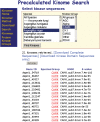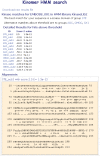Kinomer v. 1.0: a database of systematically classified eukaryotic protein kinases
- PMID: 18974176
- PMCID: PMC2686601
- DOI: 10.1093/nar/gkn834
Kinomer v. 1.0: a database of systematically classified eukaryotic protein kinases
Abstract
The regulation of protein function through reversible phosphorylation by protein kinases and phosphatases is a general mechanism controlling virtually every cellular activity. Eukaryotic protein kinases can be classified into distinct, well-characterized groups based on amino acid sequence similarity and function. We recently reported a highly sensitive and accurate hidden Markov model-based method for the automatic detection and classification of protein kinases into these specific groups. The Kinomer v. 1.0 database presented here contains annotated classifications for the protein kinase complements of 43 eukaryotic genomes. These span the taxonomic range and include fungi (16 species), plants (6), diatoms (1), amoebas (2), protists (1) and animals (17). The kinomes are stored in a relational database and are accessible through a web interface on the basis of species, kinase group or a combination of both. In addition, the Kinomer v. 1.0 HMM library is made available for users to perform classification on arbitrary sequences. The Kinomer v. 1.0 database is a continually updated resource where direct comparison of kinase sequences across kinase groups and across species can give insights into kinase function and evolution. Kinomer v. 1.0 is available at http://www.compbio.dundee.ac.uk/kinomer/.
Figures


References
-
- Cohen P. The regulation of protein function by multisite phosphorylation—a 25 year update. Trends Biochem Sci. 2000;25:596–601. - PubMed
-
- Cohen P. The role of protein phosphorylation in human health and disease. The Sir Hans Krebs Medal Lecture. Eur. J. Biochem. 2001;268:5001–5010. - PubMed
-
- Hanks SK, Quinn AM, Hunter T. The protein kinase family: conserved features and deduced phylogeny of the catalytic domains. Science. 1988;241:42–52. - PubMed
-
- Hanks SK, Hunter T. Protein kinases 6. The eukaryotic protein kinase superfamily: kinase (catalytic) domain structure and classification. FASEB J. 1995;9:576–596. - PubMed
-
- Manning G, Whyte DB, Martinez R, Hunter T, Sudarsanam S. The protein kinase complement of the human genome. Science. 2002;298:1912–1934. - PubMed

